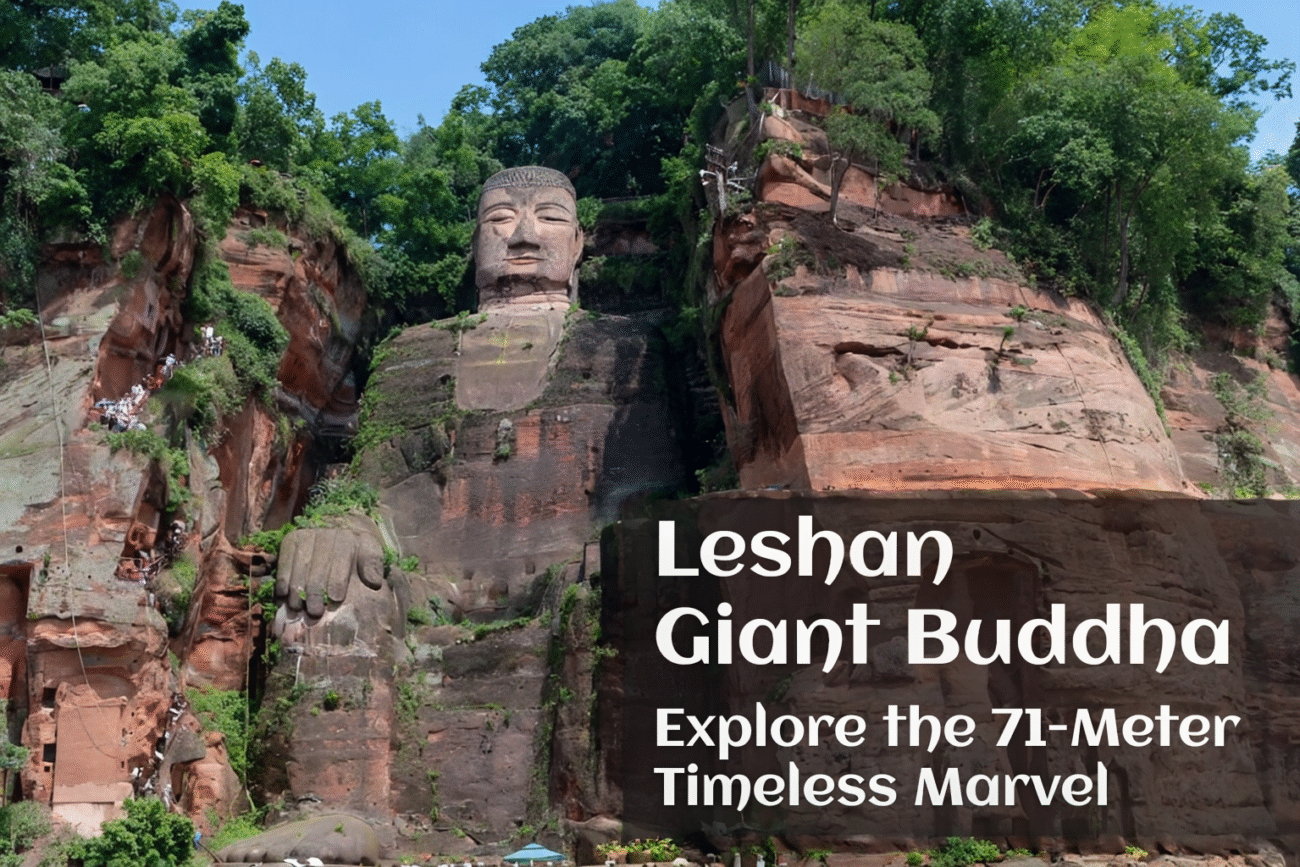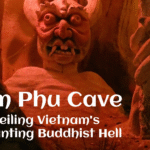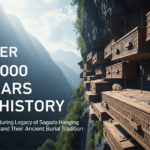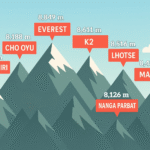In the heart of China’s Sichuan Province, a colossal figure sits in eternal meditation, watching over the meeting of three powerful rivers. This is the Leshan Giant Buddha, a breathtaking 71-meter tall statue carved directly from a cliff face more than 1,200 years ago. As the largest stone Buddha on Earth, this monument is not just a stunning work of art but a story of faith, genius, and human perseverance. It’s a place where history feels alive, where a mountain itself becomes a spiritual symbol. This article will take you on a journey to explore this incredible wonder, from its dramatic creation story to how you can experience its majesty for yourself. Prepare to be amazed by this ancient masterpiece.
The Story Behind the Stone Giant: A Monk’s Grand Vision
Every great monument has a great story, and the tale of the Leshan Giant Buddha begins with a determined monk and a dangerous problem.
A Daring Plan to Tame the Rivers
Long ago, during China’s flourishing Tang Dynasty (618–907 CE), the spot where the Min, Dadu, and Qingyi rivers meet was a place of terror. The waters were wild and turbulent, creating deadly whirlpools that swallowed ships whole and took countless lives. Local people lived in fear, believing a vicious water spirit was to blame.
In the year 713 CE, a Buddhist monk named Haitong arrived. Seeing the suffering of the people, he came up with an audacious plan. He would carve a giant statue of the Maitreya Buddha—the future Buddha of hope and light—into the cliffside overlooking the chaos. He believed the Buddha’s compassionate presence would calm the angry river spirit and protect all who traveled on the water. It was a quest that seemed impossible, but Haitong was a man of unshakeable faith.
A Monk’s Fierce Dedication
Funding such a massive project was the first great challenge. For 20 years, Haitong traveled and collected donations, slowly building the treasury for his dream. His dedication became legendary. When greedy local officials tried to steal the money he had raised, Haitong famously declared he would rather give them his own eye than surrender the funds meant for the Buddha. To prove his point, he gouged out one of his eyes, an act of shocking piety that scared the officials away.
This story, whether fact or folklore, captures the intense spirit behind the creation of this amazing ancient Chinese statue. Haitong dedicated his life to the project, overseeing the carving of the Buddha’s head and upper body. Sadly, he passed away before he could see his vision fully realized, leaving his life’s work unfinished. news.artnet.com
90 Years of Incredible Tang Dynasty Engineering
For a while, construction stopped. The dream seemed lost. But Haitong’s disciples refused to give up. They continued the work whenever they could find new patrons. First, a regional governor named Zhangchou Jianxiong funded the carving down to the knees. After another pause, a powerful military governor named Wei Gao sponsored the final push.
Finally, in 803 CE, after 90 years of back-breaking labor by thousands of artisans and workers, the Leshan Giant Buddha was complete. What started as one monk’s vision was finished through the dedication of generations. The incredible result was a testament to the remarkable skill of Tang dynasty engineering, a marvel that would stand for centuries. And as for the turbulent rivers? Legend says that as the Buddha was carved, the massive amount of stone debris that fell into the water changed the riverbed, making it calmer and safer for ships. Haitong’s dream, in a way, had come true.
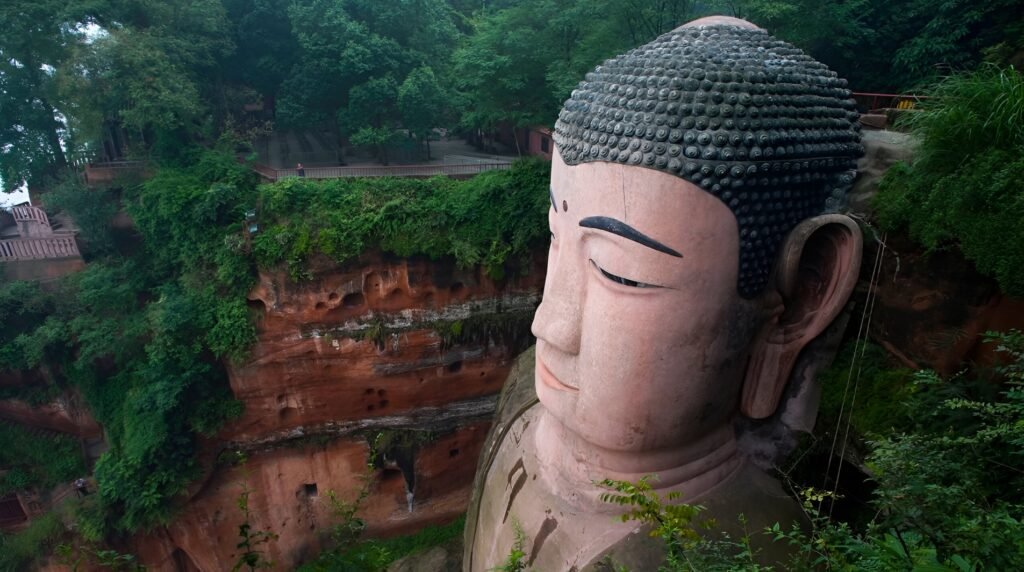
What Makes the Leshan Giant Buddha So Special?
It’s hard to grasp the sheer scale and genius of the Leshan Giant Buddha until you learn about its incredible features. It’s far more than just a big statue; it’s a masterpiece of art and science.
Mind-Blowing Size and Scale
The numbers behind this colossus are simply staggering. Standing 71 meters (233 feet) tall, it’s roughly the height of a 20-story building.
- Head: The Buddha’s head alone is nearly 15 meters tall, with ears that are 7 meters long.
- Hair: Its scalp is covered in 1,021 perfectly coiled “buns” of hair, each one intricately carved and fitted into place.
- Shoulders: The shoulders are a massive 28 meters wide—spacious enough for a large group of people to stand on.
- Hands and Feet: Each finger is over 8 meters long. The instep of its foot is 8.5 meters wide, and it’s said that even its smallest toenail is large enough for a person to sit on.
Despite its immense size, this ancient Chinese statue is perfectly proportioned, giving it a sense of grace and harmony.
A Masterpiece of Ancient Chinese Statue Art
Carved from the red sandstone cliff, the Buddha’s expression is one of serene calm. Its eyes are slightly downcast, gazing peacefully upon the rivers below. This gentle, benevolent look is a classic feature of Tang dynasty art, a period celebrated for its rich cultural and artistic achievements. The artists who carved the statue were masters of their craft, able to create a figure that feels both overwhelmingly powerful and deeply personal at the same time. The Leshan Giant Buddha is truly the pinnacle of its era’s sculptural art.
The Secret Drainage System
Perhaps the most ingenious part of the statue is something you can’t even see. The Tang dynasty builders knew that Sichuan’s rainy climate could easily erode the soft sandstone. To protect their creation, they designed a brilliant and complex drainage system hidden within the Buddha’s body.
Cleverly disguised channels and gutters were carved behind its ears, in its hair, and around its collar and arms. These channels collect rainwater and direct it away from the statue, preventing it from causing damage. This incredible feat of Tang dynasty engineering has worked for over a millennium, playing a huge role in preserving the Buddha from the elements. It’s a silent, hidden system that is key to the statue’s survival.
A Spiritual Journey: The Buddha’s Deeper Meaning
Beyond its size and engineering, the Leshan Giant Buddha is a place of deep spiritual significance, drawing pilgrims and inspiring wonder in all who visit.
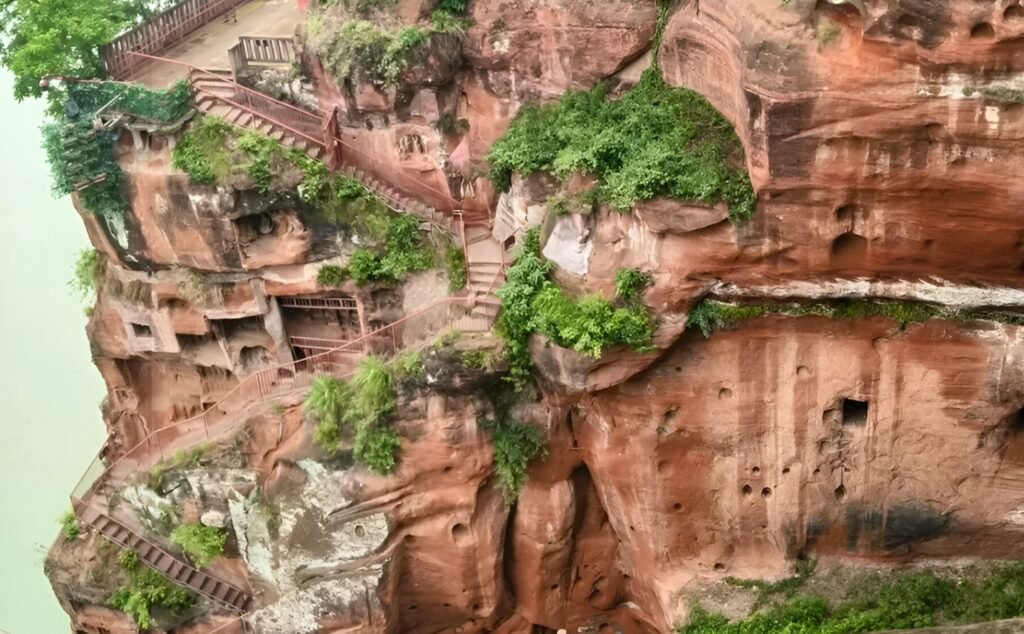
The Hopeful Gaze of the Maitreya Buddha
The statue depicts the Maitreya Buddha, a very important figure in Buddhism. Maitreya is the “Future Buddha,” who is prophesied to appear on Earth to bring an era of enlightenment and peace. By choosing to carve Maitreya, Haitong and the community were expressing a profound hope for a better, safer future.
The Buddha’s calm expression and folded hands symbolize mercy, compassion, and blessings. For centuries, pilgrims have come here to pray, burn incense, and seek protection and good fortune from this divine guardian. The belief that its presence tamed the rivers transformed it into a miraculous protector in the eyes of the local people, a role it continues to hold in their hearts today.
Part of the Sacred Mount Emei Scenic Area
The Buddha’s location adds to its spiritual power. It is part of the Mount Emei Scenic Area, a UNESCO World Heritage site and one of the Four Sacred Buddhist Mountains of China. Mount Emei is where Buddhism first took root in China, making this entire region a cradle of faith.
The Leshan Giant Buddha and Mount Emei complement each other perfectly, creating a spiritual landscape that connects the origins of Chinese Buddhism with one of its grandest expressions. For believers, visiting both sites is a profound pilgrimage through the history of their faith. The status as part of the Mount Emei Scenic Area ensures its protection and worldwide recognition.
When the Mountain Becomes a Buddha
There is a local saying: “The mountain is a Buddha and the Buddha is a mountain.” From a distance, some say the shape of the cliffs where the Buddha is carved resembles the outline of a much larger, reclining Buddha. In this view, the giant statue forms the heart of this even bigger, natural Buddha.
This poetic idea reflects how deeply the statue is woven into the landscape and the local imagination. It suggests that the carving wasn’t just an act of construction but an act of revealing something sacred that was already there. This fusion of nature and faith makes a visit to this special place even more magical.

Enjoy playing the Wordle game, where you can challenge your mind and language skills by trying to guess the hidden word within a limited number of attempts. Each guess provides you with clues about the correctness and position of the letters, adding excitement and suspense to every round.
Visiting the Leshan Giant Buddha: A Traveler’s Guide
Millions of people visit this incredible site every year. Whether you want an adventurous hike or a relaxing boat ride, there are two main ways to experience the Buddha’s grandeur.
Seeing the Buddha on Foot: The Cliffside Staircase
For an up-close and personal encounter, you can explore the park on foot. The journey starts at the top of the cliff, where you can stand on an observation deck right next to the Buddha’s head. Here, you are eye-to-eye with the giant, able to appreciate the fine details of its face and serene expression.
From there, the real adventure begins: the “Nine Turnings Plank Road.” This is a steep, zigzagging staircase carved right into the side of the cliff. As you make your way down, you get ever-changing perspectives of the Buddha’s massive body. The staircase is narrow and can be crowded, but the experience is unforgettable. At the bottom, you stand at the Buddha’s feet, looking up in awe at the full 71-meter figure. It’s a moment that truly puts its colossal scale into perspective.
The View from the Water: A Relaxing Boat Tour
If the steep staircase isn’t for you, or if you want a perfect panoramic photo, a boat tour on the river is an excellent choice. Tourist boats take you to a spot on the water directly in front of the statue. From here, you can see the Leshan Giant Buddha in its entirety, seated majestically within the cliff.
This view is impossible to get from land and highlights how the statue dominates the landscape. The boat tour is short, typically around 30 minutes, and offers a comfortable and breathtaking way to appreciate this masterpiece of Tang dynasty engineering. Many visitors choose to do both—the walk and the boat ride—to get the full experience.
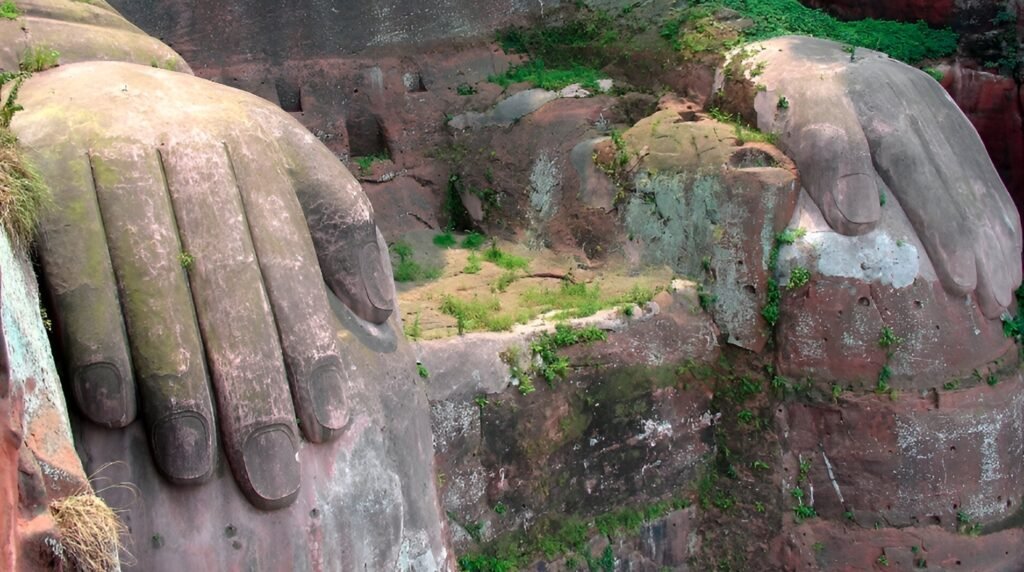
Tips for a Perfect Trip
- Wear Comfortable Shoes: Whether you walk or take the boat, you’ll be doing some walking.
- Go Early: The site can get very crowded, especially on holidays. Arrive early in the morning to beat the biggest crowds.
- Consider the Weather: Sichuan can be hot and humid in the summer. Bring water and sun protection. A poncho is useful during the rainy season.
- Choose Your View: The best photos from the boat are often in the afternoon when the sun is shining on the Buddha’s face.
Keeping the Giant Safe: A Never-Ending Task
Protecting a 1,200-year-old outdoor statue is a monumental challenge. The Leshan Giant Buddha faces constant threats from weathering, pollution, and even the millions of tourists who come to admire it.
Challenges of Time and Weather
Sichuan’s humid, rainy climate is tough on the statue’s soft sandstone. Over the centuries, rainwater has caused erosion and allowed moss and small plants to grow on its surface. In modern times, air pollution has also taken a toll, blackening the Buddha’s nose and face. These natural and man-made forces mean that constant care is needed to prevent this ancient Chinese statue from deteriorating.
Modern Efforts to Protect an Ancient Chinese Statue
Fortunately, there are dedicated efforts to preserve this world treasure. The Mount Emei Scenic Area management committee oversees regular conservation projects.
- Cleaning and Repairs: The Buddha has received several “facelifts” over the years. In major restorations, workers carefully clean off grime and vegetation, repair cracks, and reinforce weak spots.
- Fighting Pollution: To combat air pollution, nearby factories and power plants have been shut down, significantly improving air quality in the region.
- Scientific Research: Experts are now using advanced technology to study the statue. They are looking for better ways to prevent water damage and slow down erosion without harming the original stone. This forward-thinking approach combines modern science with respect for this ancient Chinese statue.
These ongoing efforts, supported by its UNESCO World Heritage status, ensure that the Maitreya Buddha of Leshan will continue to watch over the rivers for generations to come.
The Buddha’s Impact on the Local Community
The Leshan Giant Buddha is more than just a tourist attraction; it is the heart and soul of the local community and the engine of its economy.
An Engine for the Local Economy
Tourism centered around the Buddha has transformed the city of Leshan. The millions of visitors each year bring vital revenue that supports hotels, restaurants, tour companies, and countless other businesses. It has created jobs for thousands of local people, from park guides to shop owners. This has allowed many families to move from farming to new livelihoods, raising the standard of living in the region. The fame of the Mount Emei Scenic Area and its star attraction has also brought investment in better roads, public parks, and other infrastructure that benefits everyone.
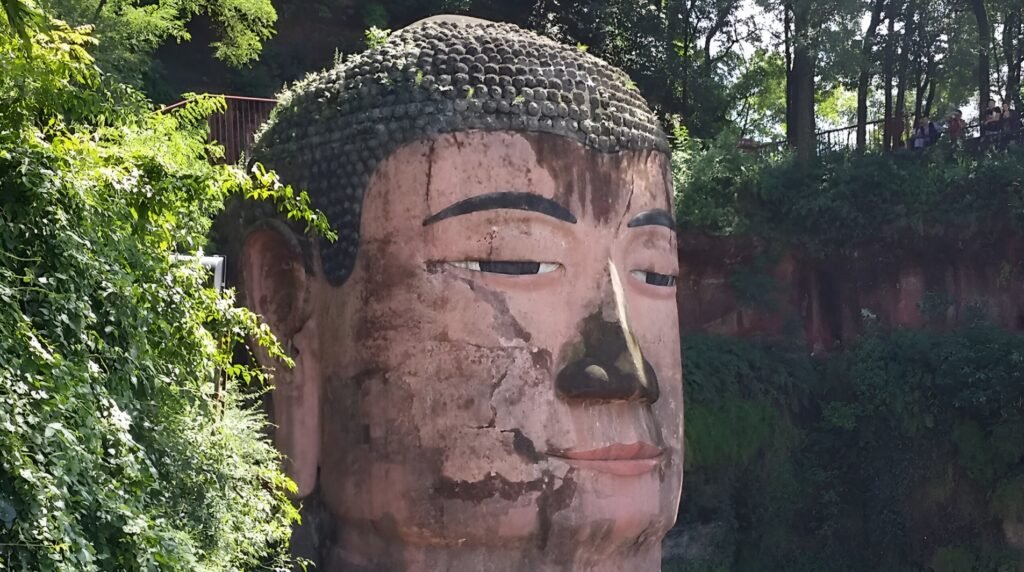
A Source of Local Pride and Identity
For the people of Leshan, the statue is a profound source of pride. They often refer to it as “our Dafo” (our Great Buddha). It’s a symbol of their history, their faith, and their cultural identity. During festivals, the site becomes a vibrant center for community gatherings, where people come together to celebrate and honor their magnificent guardian. This shared heritage strengthens community bonds and keeps the ancient stories and traditions surrounding the Maitreya Buddha alive.
Conclusion: An Enduring Legacy in Stone
The Leshan Giant Buddha is a monument that truly touches the soul. It is a story of faith powerful enough to move mountains, a marvel of Tang dynasty engineering that has stood the test of time, and a spiritual beacon that continues to inspire awe and reverence. From its origins as a monk’s prayer to calm a river, it has grown into a global symbol of cultural heritage, connecting the ancient past with the vibrant present.
Standing in its shadow, you can’t help but feel a sense of peace and wonder. The Great Buddha of Leshan is more than stone; it’s a timeless reminder of humanity’s ability to create something of breathtaking beauty and lasting meaning. It has watched over the world for thirteen centuries, and with continued care, its serene gaze will inspire humanity for many centuries more.

Discover the world’s most iconic public squares, where history, culture, and vibrant life come together. Explore breathtaking architecture and lively atmospheres in our top 12 picks. Dive into the heart of global cities visit now and experience these unforgettable urban gems!


